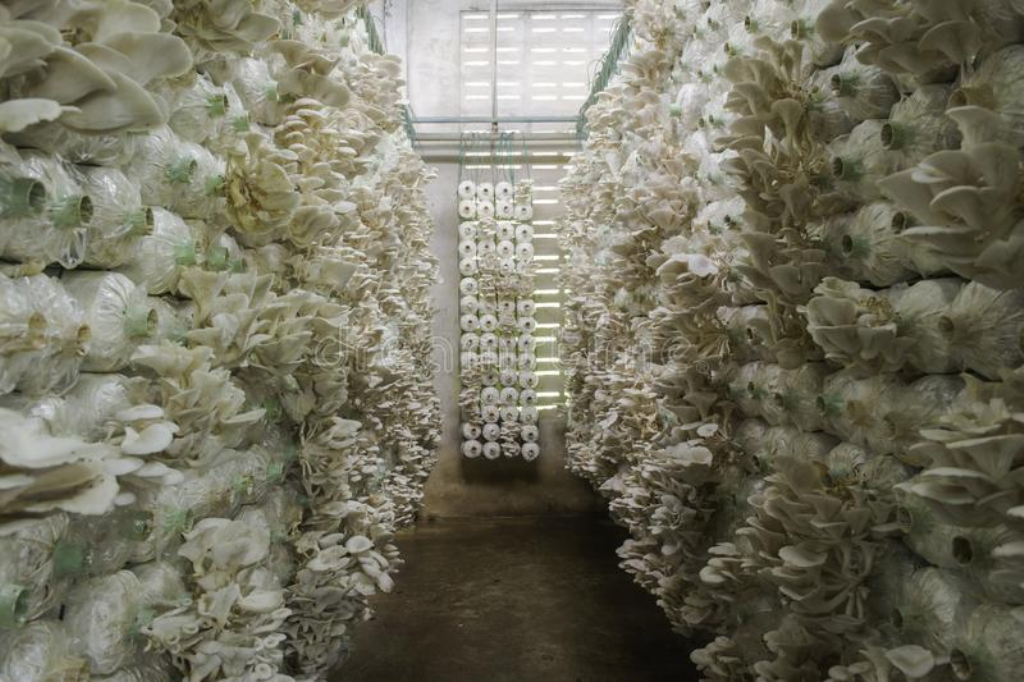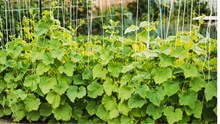
Worried about doing profitable business with limited investment or do not want to take up job from rising job insecurity, due to lockdown problems. Here is a feasible solution for rural and even urban people. With investment less than Rs 10000 per month, you can earn at least Rs 25000 every month, through Oyster farming business. Let us see how. Oyster Mushroom is the simplest to grow & most delicious to eat. This can be grown where the climatic conditions are not suitable for cultivating button mushrooms. Oyster mushroom consumption has its own merits. Firstly it has a lower fat content hence suggested for controlling obesity usually. Secondly this variety is also beneficial in controlling diabetes as well as blood pressure.
Oyster mushroom requires average temperature range of 20 – 30 degree C while humidity of 55-70 percent for a period of 6 - 8 months is needed in a year. In hilly areas - the best growing season is during March or April to September or even October. In lands at sea level i.e. on plane lands the ideal cultivation period is from September or October to March or April. Oyster mushroom can be grown on several agro-wastes like straw of paddy, wheat / Ragi, stalk & leaves of maize, millets and cotton, used citronella leaf, sugarcane bagasse, saw dust, jute and cotton waste, used tea leaf waste, useless waste paper and synthetic or even compost of button mushrooms. Industrial wastes such as paper mill sludges, coffee byproducts, tobacco waste, etc can also be used for cultivation.
Finding/creating a Mushroom House
First step in mushroom cultivation is to get or find a room, also known as mushroom house where mushroom spawns stacked and finally grown. A mushroom spawn is simply any substance that has been inoculated with mycelium, the vegetative growth of a fungus. The spawn is used to transfer mycelium onto any material from which mushrooms will grow, called a substrate. If vacant room is already available then make sure it has limited or very less outlets/vents. If outlets are many then try to cover the vents or holes with the straw or polythene bags etc. This is necessary for making the room cooler and maintaining temperature below 30 degrees, so as to ensure proper growth of the mushrooms. If room is not available then one can get a room on rent for converting into a mushroom house. A single room with moderate measurements (10 feet by 12 feet roughly) can cost Rs 3000 in a small town and even lesser in a village.

Purchasing Spawns and Disinfection of Mushroom house:
Next step is to make the floor and walls of the room free from micro-organisms so that growth process of the mushrooms does not get disturbed. Spray formalin and bevistin in the floor and walls. Then use these chemicals in the compost also, for similar reason. Spawns can be purchased either from Agricultural universities or online suppliers. Online purchases will be costly – as high as Rs 200-250 per kg while purchasing from Agricultural Universities are cheaper, easily available, costly roughly Rs 90-100 per kg and equally productive or even better. Therefore option for purchasing from the Universities will quite economical. The most widely used substrate for Oyster mushrooms is straw. However, sawdust, cardboard, coffee grounds and other byproducts of agriculture such as sugarcane bagasse and cotton waste can also be used. The National Horticulture Board recommends that in order to produce 1 kg mushroom, around 2.2 kg of dry substrate materials will be required. Cost of formalin and bevistin required for disinfecting the room and the compost with 50 kg spawn (recommended initially to start with) is Rs 500 approximately.
Spawning and Disinfection of compost:
Initially one should better start with purchasing 50 kgs of spawn. After disinfecting the floors and walls of the mushroom house, it is turn of the substrate or compost to be disinfected. Take a drum with roughly 100 Liters of water and put only that much quantity of the compost which gets submerged in water completely. Keep it for a day and then take out the compost out of the drum, to be spread in the floor and allow it to dry. After that take the polythene bags and target to put roughly 100 grams of the spawn per polythene bag. Spawning to be done in planned manner i.e. it is highly recommended (based on talks with successful mushroom growers) to place at least 3 layers of spawn in every bag, in such manner that after every layer of spawns, there should be at least 3 to 4 layers of the compost or the “Bhusa”. After this preparation make at least 10-12 smaller holes - either from pencil or any pointed object, right from bottom to top of the polythene bags, for getting proper air flow during the growth period.
Keep the spawn, stacked in polythene bags in racks, prepared from Bamboos and ropes, for at least 18-20 days in the room and maintain adequate temperature levels. For beginners, training is recommended for growing mushroom as slight error in the process can adversely affect the mushroom growth and may even damage them. It normally takes 45 days for spawns to turn into fully grown mushrooms.

Marketing
Now after production of mushrooms, final step is to sell the produce in the market. Normally are two feasible ways, given below
-
Buy back agreement
-
Self marketing
A Buy back agreement is an agreement done of stamp paper (recommended), by private institutes, where a mushroom grower and institution sign an agreement where the institution promises to buy total quantity of mushroom from the supplier or grower, with a promise of getting the entire quantity sold, after the sale, return the profit to the grower after deducted the previously decided profit margin by the institution. Generally buy back agreement is done by those institutions, where the grower undergoes training of mushroom cultivation, or purchases spawns etc. Therefore it is practically advisable that one should go for buy back agreements from such institutions only. Beginners may find it a challenge in growing without training since a minor mistake in the overall process can negatively impact mushroom growth hence undergoing training from the relevant institutions is highly recommended.
Self marketing involves entire process of taking out mushroom from the cultivation point to taking them to market place and complete the sale process. For selling one should ensure that the marketplace or Mandi is near to the production area, otherwise it will lead to rise in cost incurred. In order to increase chances of selling the entire quantity produced in short duration, say a month it is advisable that one should select 5-10 packets (Each packet can be 200-250 Grams) and give to nearest vegetable vendors who are having good number of customers and who are selling mushrooms as well. Here it is worth noting that better don’t take any money initially from the retailer. Instead, tell him that money can be given once the packets are sold. Under this situation, the vendor shall hand over the sale amount to the grower, after subtracting his profit margin.
Always remember that you need to create a market for yourself first. This act will not only enhance trust and goodwill in the mind of the retailer but increase the interest to accept the packets willingly since he does not have to pay any amount initially. Also, in case there is more than one retail/vegetable shop near your house then prefer distributing the packets in different shops so as to increase the chances of sale on the same day. In case few packets are not sold on a particular day then take it back, dry it and sell as vegetable or make pickle from it and sell it again. This eliminates the chances of mushroom packets getting wasted. Demand for dried mushroom demand is also healthy and pickles are a favorite for household consumption. So the risk for incurring losses for the unsold packets is almost eliminated and still one is able to get some profit when sold as dried mushroom or as mushroom pickle.
Expected Cash Flows: It normally takes 45 days for spawns to develop in into a fully grown mushroom. On an average the spawn is stacked racks for at least 18-20 days in the mushroom house for the growth process. Therefore each production cycle for Oyster mushroom is nearly two months. So the cash inflows and outflows should be divided by two in order to derive the monthly cost and monthly profit. The calculations are given below in tabular form: (For entire production cycle i.e. two month period)
Total Cost Incurred
|
Rent for Mushroom House |
Rs 6000 (Rs 3000 per month) |
|
Purchase Cost of 50 kg Spawn |
Rs 4750 (Rs 95 per Kg) |
|
Purchase cost of 500 Polythene Bags |
Rs 1000 ( Rs 2 per bag) |
|
*Purchase Cost Rake making (Bamboo and Ropes) |
Rs 600 ( Rs 300 monthly) |
|
Chemical treatment expenses |
Rs.500 |
|
**Transportation and packing expenses |
Rs.500 |
|
Electricity Bill (Single 9 W LED bulb sufficient) |
Rs.500 |
|
Total Cost |
Rs 12850 |
|
Monthly Cost |
Rs.6425 |
*Cost for bamboos and Rope is one time costing Rs. 15000 approximately but in entire year one can grow at least 5-6 times considering the production cycle of 2 months. Thus average monthly cost therefore gets reduced to Rs 300. (Assuming the cultivation occurs 5 times in a year)
**It includes cost of taking mushrooms in mandis or vegetable stores etc and also purchasing small packets (to be sold under 200-250 gram weight packs).
Total Revenue Earned
|
*Mushroom produced from 500 bags |
500 kgs |
|
**Average Mushroom selling price |
Rs.125 per Kg |
|
Net Revenue earned from selling 500 kgs Mushroom |
Rs.62500 |
|
Monthly Revenue Earned |
Rs 62500/2 = Rs.31250 |
* As per experts from 100 grams of spawn, one can expect nearly 1 kg of full grown mushroom. Therefore considering yield of 1 kg per bag, total production will be 500 kgs
** As per current market sources
|
Therefore Net Profit earned per month = Rs.31250-6425 Rs.25000 approximately
|
Please note that the cost has been taken slightly higher and revenues slightly lower considering the possible challenges that can raise the cost or reduce the sales. For example, the cost for using 9 W LED Bulb may be lower than Rs 500 per two months. Similarly if mushroom gets sold under 200-250 gram packets then it can be sold as high as Rs. 175-200 per kg. (Here we have taken Rs. 125/kg assuming that some packets may not get sold the very same day - they are sold later as pickles or dried mushrooms, which are cheaper than freshly sold mushrooms). All in all the net profit may be higher than the estimated number under normal scenario. Therefore the Oyster mushroom farming business is viable surely.















